This is just a sample of the many
antique sewing machines we have sold.
Click link to see other
Past Sales Archive Pages on this Site.
We Buy Quality Antiques
Contact Us at
AntiqBuyer@gmail.com
Special Note Concerning Prices Seen Below:
Most prices seen reflect actual sale results from this website.
Prices seen
span a long period of time and may not reflect current values. Some
are selling for more, many now sell for less.
On some pieces you will see no price, or a price range,
with or without an explanation. The reasons for that are discussed on the FAQ page.
Our current offering of Antiques for sale are at our sister Website Patented-Antiques.com.
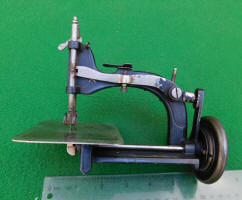 "Daisy"
Child Size Antique Sewing Machine A rare
and unusual TSM looking for its treadle base or the optional table clamp that
can be found for it. The Daisy Treadle TSM Sewing Machine is
considered the best of the toy treadles that can be found. I have
never seen the version with a removable auxiliary table clamp. A rare
thing.
"Daisy"
Child Size Antique Sewing Machine A rare
and unusual TSM looking for its treadle base or the optional table clamp that
can be found for it. The Daisy Treadle TSM Sewing Machine is
considered the best of the toy treadles that can be found. I have
never seen the version with a removable auxiliary table clamp. A rare
thing. The cosmetic condition of this unusual sewing machine is great with nearly all the original black finish & gold decoration remaining. It runs freely and smoothly. It has its original needle. The sew plate has had some nickel loss but is not rusty or pitted. It is marked with the company name, location of Cleveland Ohio, Patented July 3rd 1887 and the word Improved. The serial number is 103732.
In the treadle version the drive wheel fits through a slot cut in the table top so the machine can sit flat. With the aux clamp, the wheel sits to the outside of the table edge. This machine will look great mounted on a block of wood so that wheel is not the first thing to hit the table. Different, Rare, and Nice!!
Fine . . . . . . . $995.00 SOLD!!
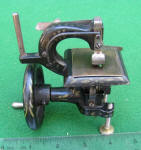 Hook Patent Sewing Machine The
cosmetic condition of this unusual sewing machine is great with nearly all the original finish and
decoration remaining. That is probably because a small spring inside
is broken and it would not operate properly. The spring is still present,
but will not attach as it was designed to due to a small break in it.
It is repairable.
Hook Patent Sewing Machine The
cosmetic condition of this unusual sewing machine is great with nearly all the original finish and
decoration remaining. That is probably because a small spring inside
is broken and it would not operate properly. The spring is still present,
but will not attach as it was designed to due to a small break in it.
It is repairable. In her Smithsonian-sponsored book on sewing machines Grace Cooper states that Albert Hook was granted the patent for this unusual machine on November 30th 1858. The machine is marked with that date. I could not find that patent using Google. In the index she calls off a number of 22179. When you run that number a reissue patent comes up, issued in 1863, as number1592. I'm not sure what that means. You can find that patent using a Google search. Hook was also granted patent number 24027 in 1859 for a similar looking machine, and that patent is also viewable on Google.
This rare antique sewing machine is incredibly small, measuring about 4" tall overall and 2" square. It has a built-in clamp to attach it to a work table. By design, it pushed a hooked needle up from below and formed a chain stitch. Very few were made, and fewer are known to exist today. Grace Cooper gives the machine a nice little write-up. The other major reference on antique sewing machines has a picture and one sentence. There are no other examples to be seen using a Google web or image search, and very little published information beyond what is found in Cooper's book.
Different, Rare, and Nice!!
Good + . . . . . . . $3950.00 SOLD!!
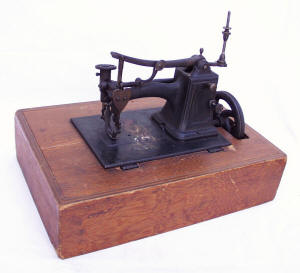 Herron's
1857 Patent Sewing Machine
This is
a rare and desirable American patent sewing machine. The patent for this
sewing machine was issued in 1857 to a Abial Herron. The only one I know
of in this country is pictured in Grace Coopers book "The Invention of the Sewing
Machine" picturing and describing the example in the Smithsonian's collection.
Herron's
1857 Patent Sewing Machine
This is
a rare and desirable American patent sewing machine. The patent for this
sewing machine was issued in 1857 to a Abial Herron. The only one I know
of in this country is pictured in Grace Coopers book "The Invention of the Sewing
Machine" picturing and describing the example in the Smithsonian's collection.
This early patented sewing machine is not mentioned or pictured in the other major book on the subject of early patented sewing machines by Carter Bays which is now in its third or fourth printing, meaning he has not been able to acquire one in all those years since his first edition came out in the early 90's. Carter is recognized by many as the top collector / expert in the US and for one of these to be missing from his collection is indicative of the scarcity of this sewing machine. In speaking with the former leading American dealer in antique sewing machines, he indicated that over the years he had one just one and that he sold it to an European collector.
The design looks somewhat like a Watson, but closer examination shows it to be quite different in setup and operation. It has several distinct differences from those also rare machines. This sewing machine is marked with the patentees name Herron and the 1857 date on a heart shaped brass plaque on the front of the machine above the needle.
The condition is OK. There is about 50-60% of the paint and decoration remaining. Cooper describes these machines as being provided with a handcrank or adapted to use as a treadle machine. A previous owner has made a small table for this one so it would display properly. It is unknown what an original set-up would look like or what the treadle looked like. There are no other examples to compare this too, and the one Cooper shows is just the head. This machine has one minor condition problem in the casting. There is a crack in the casting holding the main drive rod. It is a weak point in the casting, and the piece you see was broken loose. It was drilled and pinned and is now solid & stable although you can still see the crack. The machine turns over freely, and its operation can be observed and demonstrated.
Excellent . . . . .$2950.00 SOLD!!
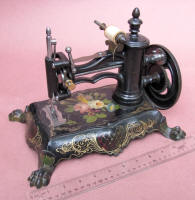 Ketchum
Patent Sewing Machine
This "paw foot" sewing machine is also a
"Ketchum's Patent" with a mid 1860's patent date on the needle plate on the
top. This patent covers the stitch mechanism, and similar sewing
machines can also be found marked "Shaw & Clark" or "Wilson", just two of
the many competitors in the early sewing machine market. The condition
of this one is super with 90% or more of the original decoration. They
are often found with little or none of this hand-painted designs on the body
and base. A nice example!!
Ketchum
Patent Sewing Machine
This "paw foot" sewing machine is also a
"Ketchum's Patent" with a mid 1860's patent date on the needle plate on the
top. This patent covers the stitch mechanism, and similar sewing
machines can also be found marked "Shaw & Clark" or "Wilson", just two of
the many competitors in the early sewing machine market. The condition
of this one is super with 90% or more of the original decoration. They
are often found with little or none of this hand-painted designs on the body
and base. A nice example!!Paw Foot Machines of this style date from the mid 1860's and were still being produced into the late 1870's before more standardized and advanced designs pushed them from the market. Many of these machines are found with no maker or patent information on them and they are most probably knockoffs trying to avoid patent infringements. Some of those machines are very nicely done. Many are unmarked, and nearly every one is done is a slightly different decoration as they were hand done back then.
Good + . . . . . . .$1250.00
SOLD!
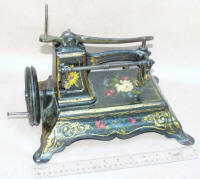
The condition is great with large amounts of original decoration
and finish remaining. It appears that at some point a coat of clear
gloss finish was applied, and this may be original. There are areas
where it has turned yellowish as one would expect from a finish over 100
years old. This is a rare and historically significant sewing
machine, and one which does not appear on the market very often.
It has a great look and will make for great display
Good + . . . . . .$3250.00 SOLD!
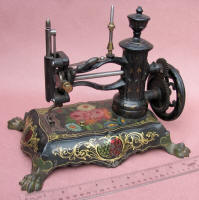
Good + . . . . . . .$950.00
SOLD!
W.G. Wilson "Paw Foot" type Sewing
Machine
There
are many variations of the antique sewing machines that are collectively referred
to as "Paw Foot" designs. The Biddeford, Maine company known as Shaw &
Clark was one of the most prolific manufacturers of paw foot machines, producing
over half a dozen different variations during the 1860's. Another lesser
known manufacturer of this style of sewing machine was the Midwestern company
referred to as W.G. Wilson, who produced machines under Ketchum's April 28,
1863 patent. This is an example of one of their machines, and it is so
marked with the patent info on the stitch plate. This early chain-stitch
sewing machine is spectacular in its design and its colorful embellishment.
It retains much of its original brightly colored floral paint and gold pinstriping.
Note the details of the fire hydrant style body topped with an elegant finial,
the ornate scalloped-edge base, and the well-defined feet. This machine
utilized the New England style "walking" presser foot to move the fabric along
instead of the more typical feeddog mechanism, and an unusual horizontal spool
pin for the thread. Oftentimes these machines are found in much lesser
condition, so if you have been waiting for one the you'll be proud to display
be sure to take a close look at this great example!
Good
. . . . .$950.00 SOLD
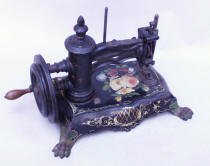 Early Paw Foot Style Sewing Machine
This style
of "paw foot" sewing machine is known by several different names and comes in
a number of different variations. They are occasionally found marked "Ketchum's
Patent", which would cover the stitch mechanism, and they can also be found
marked "Shaw & Clark" or "Wilson", just two of the many competitors in the early
sewing machine market. Machines of this style date from the mid 1860's
and were still being produced into the late 1870's before more standardized
and advanced designs pushed them from the market. Many of these machines
are found with no maker or patent information on them, and this example is one
of the unmarked ones. They are often described by the shape of the
pillar or column, and this one would be known as a fire hydrant model.
Other typically seen styles are the fluted column model, the skinny column,
the open or closed square column, and others. The operation and design
of all are pretty much the same. This type of machine forms a single thread
chain stitch utilizing no bobbin or second thread to form a lockstitch.
Their attractive designs make them highly sought after, but they are typically
found in horrible condition with little remaining paint. This example on the
other hand is quite nice with approximately 80%-90% of the original paint and
decoration remaining.
Early Paw Foot Style Sewing Machine
This style
of "paw foot" sewing machine is known by several different names and comes in
a number of different variations. They are occasionally found marked "Ketchum's
Patent", which would cover the stitch mechanism, and they can also be found
marked "Shaw & Clark" or "Wilson", just two of the many competitors in the early
sewing machine market. Machines of this style date from the mid 1860's
and were still being produced into the late 1870's before more standardized
and advanced designs pushed them from the market. Many of these machines
are found with no maker or patent information on them, and this example is one
of the unmarked ones. They are often described by the shape of the
pillar or column, and this one would be known as a fire hydrant model.
Other typically seen styles are the fluted column model, the skinny column,
the open or closed square column, and others. The operation and design
of all are pretty much the same. This type of machine forms a single thread
chain stitch utilizing no bobbin or second thread to form a lockstitch.
Their attractive designs make them highly sought after, but they are typically
found in horrible condition with little remaining paint. This example on the
other hand is quite nice with approximately 80%-90% of the original paint and
decoration remaining.
Excellent
. . . . .$950.00 SOLD
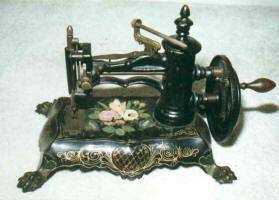 Early Paw Foot Style Sewing Machine
The condition is very nice!!
Early Paw Foot Style Sewing Machine
The condition is very nice!!
Excellent
. . . . .$1450.00 SOLD
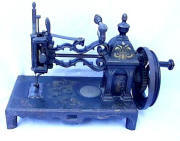 Shaw
& Clark Closed Pillar Sewing Machine from Biddeford, Maine
The several different models of vintage sewing machines
produced by this Maine company are some of the best known and most actively
sought after of all antique sewing machines from the early era of production
in the mid to late 1800's. Shaw & Clark put out a half dozen or so different
models over the years, and they have come to be referred to by nicknames that
attempt to describe their distinguishing feature. This example is known
as Shaw & Clark's "closed pillar" model. (As an aside, there are also
the "open pillar", the "fire hydrant", the "skinny pillar", and a few more variations.)
There are also a large number of early knockoffs that are often referred to
as " Shaw & Clarks", but which really not---they were manufactured in competition
during this era in violation of this company's patents, thus partially explaining
their being unmarked. This one is clearly marked with the Shaw & Clark
name boldly cast into the bottom of the base as well as on the brass medallion
where the patent information can be found next to the pillar. The
condition of this antique sewing machine is very good---many it seems are found
with virtually no paint remaining and only occasionally are they found
in near pristine condition. This one, thought not pristine, is very good
with most of the decorative and colorful floral design remaining.
Shaw
& Clark Closed Pillar Sewing Machine from Biddeford, Maine
The several different models of vintage sewing machines
produced by this Maine company are some of the best known and most actively
sought after of all antique sewing machines from the early era of production
in the mid to late 1800's. Shaw & Clark put out a half dozen or so different
models over the years, and they have come to be referred to by nicknames that
attempt to describe their distinguishing feature. This example is known
as Shaw & Clark's "closed pillar" model. (As an aside, there are also
the "open pillar", the "fire hydrant", the "skinny pillar", and a few more variations.)
There are also a large number of early knockoffs that are often referred to
as " Shaw & Clarks", but which really not---they were manufactured in competition
during this era in violation of this company's patents, thus partially explaining
their being unmarked. This one is clearly marked with the Shaw & Clark
name boldly cast into the bottom of the base as well as on the brass medallion
where the patent information can be found next to the pillar. The
condition of this antique sewing machine is very good---many it seems are found
with virtually no paint remaining and only occasionally are they found
in near pristine condition. This one, thought not pristine, is very good
with most of the decorative and colorful floral design remaining.
Very Good
. . . . .$1650.00 SOLD
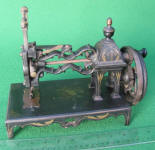
Very Good
. . . . .$2495.00 SOLD
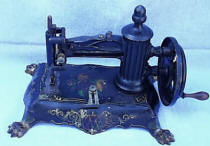 Paw
Foot Cast Iron Sewing Machine by Shaw & Clark
This style
of sewing machine, circa 1860-70, is generally attributed to the Shaw
& Clark Co. of Biddeford, Maine or assorted other New England manufacturers.
There are many interesting variations in the design of these machines that exist,
but all utilize a revolving hook chain-stitch mechanism and a walking presser
foot. This example features a ribbed fire hydrant style body topped with
an acorn-shaped finial. There is still a good amount of original black
paint and colorful floral / gold scroll decoration remaining, although the base
does show some minor areas of surface rust. The spool holder on this example
is missing, but still a good one to add to the collection.
Paw
Foot Cast Iron Sewing Machine by Shaw & Clark
This style
of sewing machine, circa 1860-70, is generally attributed to the Shaw
& Clark Co. of Biddeford, Maine or assorted other New England manufacturers.
There are many interesting variations in the design of these machines that exist,
but all utilize a revolving hook chain-stitch mechanism and a walking presser
foot. This example features a ribbed fire hydrant style body topped with
an acorn-shaped finial. There is still a good amount of original black
paint and colorful floral / gold scroll decoration remaining, although the base
does show some minor areas of surface rust. The spool holder on this example
is missing, but still a good one to add to the collection.
Good+
. . . . .$750.00 SOLD
Foley & Williams
"Practical" Round Wooden Sewing Machine
This is a rare variation of
the more commonly seen Triumph Sewing Machine that was made by the same manufacturer
Foley & Williams back near the turn of the century. That is not, by any
means, to say that the Triumph is a common machine, but over the years, if we
have seen 50 or owned a handful of those, this is only the second one of the
Practical we have ever had the opportunity to buy or offer for sale.
If you are not familiar with the design, the entire body and base are made of
wood, and this is typically referred to as the doughnut machine. There
is a metal frame on the backside to reinforce this.
The missing
paint and finish on the base is simply honest wear from where this machine was
clamped to the table during use. At different periods, machines like this
were marketed as either toys for the child to learn and practice on, or they
were also marketed as travel machines for use in the summer home or on trips
to do simple mending. This machine is in very nice condition noting the
base . The removable piece of the circle, on the left, and pin to hold
it, are present and original. A difficult to find machine!
Very Good
. . . . .$1450.00 SOLD
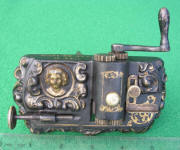
This example is in near mint condition, still exhibiting most of its original gold gilding. It is complete with its edge guide, screw feed,
and the cast
iron screw clamp that fits underneath and was used to attach it to a table edge The
patent info is along the edge. This example is slightly different than those pictured in Carter Bays' book
and there were several different variations produced.
The idea or novelty of this machine must have been appealing, as there are several other varieties of this style machine that are known. They were produced
during the same early 1860's pre-Civil War period. The copied models were probably bootleg models to try and horn in on this fellow's "wonderful"
idea and profit margin. The most commonly seen is the "Family Gem", which is pretty much an exact copy minus the lady head cast into the body.
It does carry the same patent dates.
It is amazing that one could find anybody to buy one of these as they are such a silly idea. I would bet that I could beat this machine's output with a
needle and thread in hand, and I cannot sew, but that is the sort of thing that makes for great collectibles. This "sewing machine" is an important
link in the development of the early American sewing machine and they are very graphic and beautiful in form. These are not offered very often, and
are quite hard to find in this nice condition these days. Highly recommend!
Fine + . . . . . . .$1250.00 SOLD!!
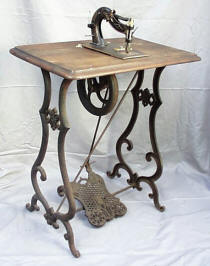 Rare
1860's Patent Williams & Orvis Treadle Sewing Machine Williams & Orvis
was a Boston-based company that manufactured sewing machines for just a few
short years from 1858 to the mid 1860's, according to the Smithsonian book on
antique sewing machines by Grace Rogers Cooper. Examples of this machine
are few and far between and this example is the first one we have ever owned
or offered. This version is known as the second model, and it features
a wonderful figural head design that resembles a dolphin or other such graceful
creature. The elegant form is especially striking because of it's petite
size. This treadle machine is unusual in that it is friction-driven, utilizing
a large flywheel that is mounted underneath. Rather than being attached
to the machine with a belt, the flywheel presses against a rubber ring that
is fastened directly to the machine's drive-wheel. This example still
retains much of the gilt decoration that is so often worn off of these early
machines. And if you look closely you can still make out the manufacturer's
name and location in the gold lettering that appears at the base of the arm.
The stitchplate is clearly marked "Patent Applied For". The finish is
no doubt in such nice condition due to the fact that the wooden hood or cover
has remained intact with the machine. The decorative cast iron treadle
stand is in excellent condition as well, with no cracks or breaks in the casting.
The pin that attaches the rod to the treadle plate has been replaced with a
nail which could easily be changed out if wanted. This is a hard-to-find
early patented sewing machine in outstanding condition.
Rare
1860's Patent Williams & Orvis Treadle Sewing Machine Williams & Orvis
was a Boston-based company that manufactured sewing machines for just a few
short years from 1858 to the mid 1860's, according to the Smithsonian book on
antique sewing machines by Grace Rogers Cooper. Examples of this machine
are few and far between and this example is the first one we have ever owned
or offered. This version is known as the second model, and it features
a wonderful figural head design that resembles a dolphin or other such graceful
creature. The elegant form is especially striking because of it's petite
size. This treadle machine is unusual in that it is friction-driven, utilizing
a large flywheel that is mounted underneath. Rather than being attached
to the machine with a belt, the flywheel presses against a rubber ring that
is fastened directly to the machine's drive-wheel. This example still
retains much of the gilt decoration that is so often worn off of these early
machines. And if you look closely you can still make out the manufacturer's
name and location in the gold lettering that appears at the base of the arm.
The stitchplate is clearly marked "Patent Applied For". The finish is
no doubt in such nice condition due to the fact that the wooden hood or cover
has remained intact with the machine. The decorative cast iron treadle
stand is in excellent condition as well, with no cracks or breaks in the casting.
The pin that attaches the rod to the treadle plate has been replaced with a
nail which could easily be changed out if wanted. This is a hard-to-find
early patented sewing machine in outstanding condition.
Excellent . . . . .$2450.00 SOLD
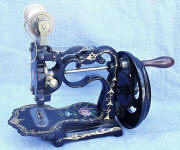 New England Style
Patented Antique Sewing Machine
These are a very early design. They are also very common and were made
for a long time under a number of names. What is uncommon is to
find them in nice condition. It is one of the nicest
we have seen!
New England Style
Patented Antique Sewing Machine
These are a very early design. They are also very common and were made
for a long time under a number of names. What is uncommon is to
find them in nice condition. It is one of the nicest
we have seen!
Excellent . . . . .$650.00 SOLD
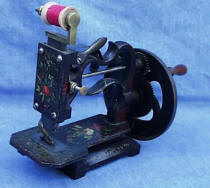 1858
Patent New England Style Sewing Machine
These antique sewing machines
are commonly referred to as New England-styles, and were actually made
by many different manufacturers both here in the US, Canada and in England,
where they were known as the Weir. These machines feature an unusual "walking"
presser foot to move the fabric along from above, rather than the more typical
underneath feed-dog mechanism. This particular example has been in our
collection for some time, as we were intrigued by the design and decoration.
Generally they are done in floral designs, and this one is also on the base,
but the end plate has what appears to be a tomato, grapes, and cherries.
The condition of the paint is super. So many of these machines are worn
almost completely bare, but not this example. It is one of the nicest
we have seen!
1858
Patent New England Style Sewing Machine
These antique sewing machines
are commonly referred to as New England-styles, and were actually made
by many different manufacturers both here in the US, Canada and in England,
where they were known as the Weir. These machines feature an unusual "walking"
presser foot to move the fabric along from above, rather than the more typical
underneath feed-dog mechanism. This particular example has been in our
collection for some time, as we were intrigued by the design and decoration.
Generally they are done in floral designs, and this one is also on the base,
but the end plate has what appears to be a tomato, grapes, and cherries.
The condition of the paint is super. So many of these machines are worn
almost completely bare, but not this example. It is one of the nicest
we have seen!
Excellent . . . . .$450.00 SOLD
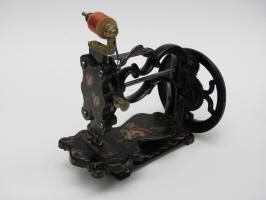 New England Style
Patented Sewing Machine The condition of this machine is very good with nearly all the
original black paint remaining. There is no rust or corrosion to the metal parts.
It has a lot of gold highlighting and floral decorations on the end plate and
bed. An interesting machine you do not find every day and certainly
not in this nice condition.
New England Style
Patented Sewing Machine The condition of this machine is very good with nearly all the
original black paint remaining. There is no rust or corrosion to the metal parts.
It has a lot of gold highlighting and floral decorations on the end plate and
bed. An interesting machine you do not find every day and certainly
not in this nice condition. Good + . . . . . . .$595.00 SOLD!
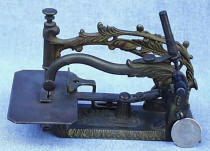 Rare
"Foliage" Figural Sewing Machine
This rare and unusual antique
sewing machine was manufactured by D. W. Clark of Bridgeport, CT. It was
patented in 1858 and produced for just a few short years, which explains why
so very few of them are ever seen except in long-time collections. (Several
years ago one came up for sale at a German auction house and brought just over
$7K.) Although often referred to as being cast brass it is actually made
of a material known as gunmetal, a harder and stronger brass-type alloy.
With its diminutive size---it measures only about 6" across and 4" high---and
its appealing foliage-like casting design, it is undoubtedly one of the most
graphic and beautifully designed of all antique sewing machines ever produced,
large or small. This example is in excellent condition and completely
original. The patent information is clearly stamped on the underside.
An early and historically significant American patented sewing machine!
Rare
"Foliage" Figural Sewing Machine
This rare and unusual antique
sewing machine was manufactured by D. W. Clark of Bridgeport, CT. It was
patented in 1858 and produced for just a few short years, which explains why
so very few of them are ever seen except in long-time collections. (Several
years ago one came up for sale at a German auction house and brought just over
$7K.) Although often referred to as being cast brass it is actually made
of a material known as gunmetal, a harder and stronger brass-type alloy.
With its diminutive size---it measures only about 6" across and 4" high---and
its appealing foliage-like casting design, it is undoubtedly one of the most
graphic and beautifully designed of all antique sewing machines ever produced,
large or small. This example is in excellent condition and completely
original. The patent information is clearly stamped on the underside.
An early and historically significant American patented sewing machine!
Excellent . . . . . SOLD
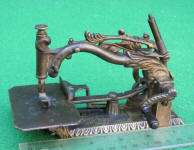 Rare
"Foliage" Figural Sewing Machine This is the third one of these I have had and sold in 30 some years.
They were the only 3 I had ever seen or heard of.
The first and least expensive was bought on eBay
and sold to a collector who never bothers to go there for a number of
reasons. The other two were consigned to me by the owners after
they had found reference on this site to the first one I had sold.
I can help you sell your as well.
Rare
"Foliage" Figural Sewing Machine This is the third one of these I have had and sold in 30 some years.
They were the only 3 I had ever seen or heard of.
The first and least expensive was bought on eBay
and sold to a collector who never bothers to go there for a number of
reasons. The other two were consigned to me by the owners after
they had found reference on this site to the first one I had sold.
I can help you sell your as well. Excellent . . . . . SOLD
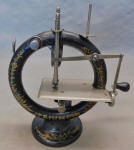 Patented
Triumph Round Wooden Sewing Machine The
Triumph is a scarce miniature sewing machines that features one of the most unusual and graphic designs
that was ever thought up for a toy sewing machine! The
round body is all wood, painted black and has applied decals for the Triumph
name and vine & berry decorations. There is a metal backing plate to
add strength and allow for the metal parts to operate. The wooden body was designed
with a small section of frame that could be removed while sewing to allow fabric to pass
through, then replaced when not in use to keep it stable. It is believed to have been manufactured by
the Foley & Williams Co. and is simply marked "Patent" on the
nickeled sew plate.
Patented
Triumph Round Wooden Sewing Machine The
Triumph is a scarce miniature sewing machines that features one of the most unusual and graphic designs
that was ever thought up for a toy sewing machine! The
round body is all wood, painted black and has applied decals for the Triumph
name and vine & berry decorations. There is a metal backing plate to
add strength and allow for the metal parts to operate. The wooden body was designed
with a small section of frame that could be removed while sewing to allow fabric to pass
through, then replaced when not in use to keep it stable. It is believed to have been manufactured by
the Foley & Williams Co. and is simply marked "Patent" on the
nickeled sew plate. This example is 100% complete with all of it's original parts, including the removable section and its retaining pin. It has a walking presser foot mechanism. The tensioner and spool pin are both present as well. It has some wear to the name and other decals as seen, but is in overall very nice condition. A "top-shelf" small TSM sewing machine for the collection.
Good + . . . . . $1150.00 SOLD!!
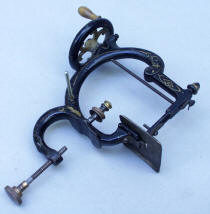 Early
Patented Hancock Integral-Clamp Antique Sewing Machine
The first sewing
machines had barely been invented when Henry J. Hancock received his 1867 patent
for this unusual chain stitch machine. The design of this early sewing
machine, with its very delicate open-frame "skeleton" body and integral clamp,
is incredibly appealing. Examples of this unusual sewing machine are extremely
scarce. Hancocks were only produced for 10 or so years which explains
why they are seldom found and rarely offered for sale. For those antique
sewing machine collectors who seek out examples of the very earliest patents,
this machine is always at the top of their "want list". This particular
example came straight out of a Midwestern estate. The stitchplate is clearly
marked with the 1867 patent date as well as 1868 and 1869 patent improvement
dates. There are no casting flaws or cracks in the delicate casting, and
although there is considerable paint loss, the surface exhibits a dark rich
patina that one would expect from a 130-year-old antique. There is no
pitting or rust, and all and all it looks very good. Likewise the brass
parts have not been polished and retain a deep mellow tone. As is generally
the case in machines of this age, the needle is missing, but other than that
the sewing machine is complete. The seam guide has been adapted from a
different newer sewing machine to resemble the original.
Early
Patented Hancock Integral-Clamp Antique Sewing Machine
The first sewing
machines had barely been invented when Henry J. Hancock received his 1867 patent
for this unusual chain stitch machine. The design of this early sewing
machine, with its very delicate open-frame "skeleton" body and integral clamp,
is incredibly appealing. Examples of this unusual sewing machine are extremely
scarce. Hancocks were only produced for 10 or so years which explains
why they are seldom found and rarely offered for sale. For those antique
sewing machine collectors who seek out examples of the very earliest patents,
this machine is always at the top of their "want list". This particular
example came straight out of a Midwestern estate. The stitchplate is clearly
marked with the 1867 patent date as well as 1868 and 1869 patent improvement
dates. There are no casting flaws or cracks in the delicate casting, and
although there is considerable paint loss, the surface exhibits a dark rich
patina that one would expect from a 130-year-old antique. There is no
pitting or rust, and all and all it looks very good. Likewise the brass
parts have not been polished and retain a deep mellow tone. As is generally
the case in machines of this age, the needle is missing, but other than that
the sewing machine is complete. The seam guide has been adapted from a
different newer sewing machine to resemble the original.Good + . . . . .$1295.00 SOLD
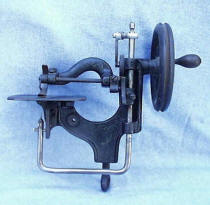 Novelty Integral-Clamp Antique Sewing Machine Not sure how they picked the name for this machine, but it is kind of a
novel idea with the needle coming up from below. It
was worth a patent and it is a difficult machine to find.
Novelty Integral-Clamp Antique Sewing Machine Not sure how they picked the name for this machine, but it is kind of a
novel idea with the needle coming up from below. It
was worth a patent and it is a difficult machine to find. Good + . . . . .$1295.00 SOLD
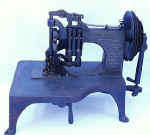 Patented
Leather Folding / Sewing Machine
This unusual device has about a half dozen patents. It was meant
for the shoe making industry and while it looks like a sewing machine it
has no needle. It was designed to cut, fold and make seams.
Like many patents from this era they make for difficult reading.
Patented
Leather Folding / Sewing Machine
This unusual device has about a half dozen patents. It was meant
for the shoe making industry and while it looks like a sewing machine it
has no needle. It was designed to cut, fold and make seams.
Like many patents from this era they make for difficult reading.
Good . . . . .$450.00 SOLD
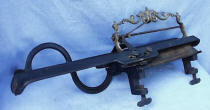 Early
Patented Lamb Knitter I do believe
you could whip out a sweater or pair of mittens just as quick as you can turn
the crank on this antique knitting machine, assuming you could figure it out!
Marked on a brass medallion on the end is "The Lamb Knitting Machine Manf'g
Co. Rochester, NY" as well as the very early patent dates of Oct. 10, 1865 and
Sept. 15, 1868. It is also marked with the number 1815, which I assume
is the serial number.
Early
Patented Lamb Knitter I do believe
you could whip out a sweater or pair of mittens just as quick as you can turn
the crank on this antique knitting machine, assuming you could figure it out!
Marked on a brass medallion on the end is "The Lamb Knitting Machine Manf'g
Co. Rochester, NY" as well as the very early patent dates of Oct. 10, 1865 and
Sept. 15, 1868. It is also marked with the number 1815, which I assume
is the serial number.This antique knitting device is very graphic and very mechanical, and there are several extras to go with it. Just in case you need help figuring out how it works the original 30-page instruction booklet is included. It is in the condition you would expect for a booklet that is over 100 years old---the pages are very readable, although they are rather brittle with tears here and there, and the cover as well as some istlets, undershirts, nubias, tidies, stockings, sweaters, mittens and gloves. Also included is a 24-page 1884 catalog and price list of assorted models of Lamb Knitting Machines and accessories. The amazing thing is that this machine cost well over $100 back then at the same time that Sears Roebuck was selling treadle sewing machines for just $15 or so. Finally several of the accessories themselves are included and they are pictured.
Good + . . . . .$650.00 SOLD
This is just a sample of the many
antiques & collectibles we have sold.
Click link to see other
Sales Archive Pages on this Site.
We Buy Quality Antiques
Contact Us at
AntiqBuyer@gmail.com
Our current offering of Antiques for sale are at our sister Website Patented-Antiques.com.
This website is Copyrighted
Larry & Carole Meeker